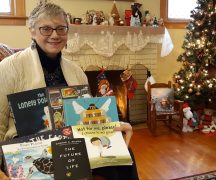By JAN LARSON McLAUGHLIN
BG Independent News
‘Tis the season for depression and disappointment.
Though the holidays are expected to bring cheer and glad tidings, to many the season stirs feelings of sadness and inferiority.
The holidays are then followed up by months of cold days and prolonged darkness, leading to the “winter blues” for some.
“This season brings out the best and worst of everybody,” Aeryn Williams, director of Family Service of Northwest Ohio, in Wood County, said during a recent presentation on “Surviving the Winter Blues” sponsored by the National Alliance on Mental Illness of Wood County.
First, comes Christmas – a time when many people strive for the perfect family Christmas cards with everyone in matching outfits, unique gifts for teachers, and the latest trendy recipes on Pinterest.
But reality often intrudes with kids screaming on Santa’s lap, the annual retail rush, and recipes gone wrong.
“We end up comparing ourselves to Martha Stewart or Pinterest,” Williams said. And inevitably, we can’t live up to those lofty goals. “Comparison is the theft of joy.”
Williams shared her own experience of trying a homemade Peppermint Patties cookie recipe with her niece. The cookies came out looking more like a mess left by the dog on the lawn, than the picture perfect samples on Pinterest.
But her 7-year-old niece came to the rescue.
“She said, ‘We might not be making Peppermint Patties, but we’re making memories,’” Williams recalled.
The Christmas season not only makes us strive for perfection, but also for super-human strength, Williams said. We look forward to the season all year, “but before you know it, your calendar is jam packed and we’re stressed out.”
Williams offered some advice that can actually be used year-round.
“’No’ is a complete sentence,” she said. “During the holidays, we don’t feel we can say ‘No.’”
Prioritize. Maybe you should skip the cookie exchange this year, or miss the annual gathering with people you hardly know.
“Stop ‘should-ing’ all over yourself,” Williams said.
Give yourself a break. Instead of putting the holiday lights up outside, make a hot chocolate and curl up for a holiday movie.
And try to not get bogged down by the emotional weight we tend to hang on the holidays – especially New Year’s.
“This time of year we spend a lot of time thinking how things were this past year, and hoping how things will be in the future,” Williams said. We can focus so much on the past and the future that we miss the present. “The present moment is the only moment available to us, and it is the door to all moments.”
The season can be particularly hard on people who have lost loved ones. It’s natural for those left behind to have strong memories of people missed at Christmas.
“Grieving is always messy,” but even more so at the holidays, she said.
Williams reminded that when grieving, it’s OK to remember, as well as to forget. It’s OK for things to stay the same, or for things to change. And it’s OK to cry, but it’s also good to laugh and enjoy the holidays.
Some people make it through the holidays, only to be hit with waves of sadness during the cold, dark winter months. Previously called Seasonal Affective Disorder, the condition is now referred to as Major Depressive Disorder of Cyclic Pattern. An estimated 10 million people are affected by some degree of this disorder.
“I hear people say, ‘It’s all in their heads,’” which Williams acknowledges is true since the condition affects brains. “It’s real.”
Women are more likely to be affected than men. The effects worsen in January and February, as people tend to hibernate.
The “winter blues” are blamed on the reduced level of sunlight, which can disrupt internal clocks and lead to depression, decrease serotonin which is a brain chemical that affects mood, and disrupt melatonin which helps with sleep patterns and mood.
Standard coping skills suggested by Williams included:
- Maintain your sleep schedule. Too much or too little sleep worsens the symptoms.
- Eat right, including plenty of Vitamin D.
- Get light. Daylight is the best, but a sun lamp can help. “Just walking outside during your lunch break helps,” even if the skies are overcast, she said.
- Maintain at least one thing to look forward to in your schedule.
Williams also suggested a technique called “acting opposite.”
“Identify the emotion that is opposite of what you are feeling, and do something that helps you experience that emotion,” she said.
For example, if you are feeling stressed, do a relaxing activity like taking a walk. If you feel depressed, instead of eating a bowl of ice cream, do some exercise. If you feel like hibernating, make plans to do something with a friend.
Williams went a step further, and said if you feel like crying, make yourself laugh. Her audience was incredulous – until they gave it a try.
“After a couple seconds, you’re not just faking it,” she said. “When your face smiles, whether you mean it or not,” the brain thinks you are smiling – which is an action that accompanies happiness.
“Our brains do amazing things to help us,” she said.
It’s also important to realize when outside help is needed, Williams said. Feelings of depression are natural, but when they stick around and make life impossible to enjoy, then it’s time to find help.
“If you are with people you enjoy, and you would really just rather go home, it may be time to reach out” and see a counselor, she said. “You might need help and support to get there.”
“People suffer the most when they try to keep it a secret,” Williams said.





